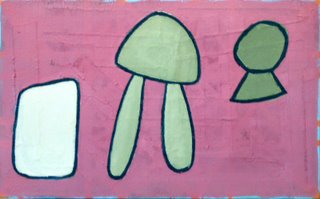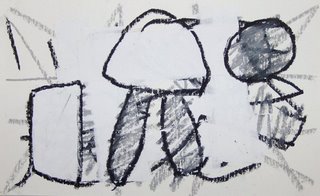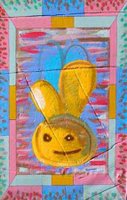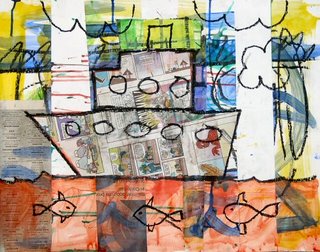Saturday, May 27, 2006
Drawing to Painting


The drawing was done in life drawing. I use the drawings as models for paintings. Here I’ve paired up a drawing to a painting. When I'm drawing it's much like just a state of mind with an arm and a hand attached. Very loose and free flowing, very unconscious.
What happens is I do the drawings, many more then I actually need. Then I edit them down to the best ones and use them as models for the paintings. That's where the deliberate part comes in. I like to think of it as a balanced ying & yang thing.
Friday, May 19, 2006

I started out in art school and then got into engineering. I’m now a civil engineering draftsman/designer. I work on a computer using AutoCAD. But I was making art for a good 10 years before engineering ever occurred to me.
I have borrowed some ideas from engineering for use in my art. In drafting there are a lot of uses of symbols to help convey the meaning of the drawing. For instance north arrows, scale bars, section symbols. Sometimes color is used in a drawing to bring attention to various features in a drawing. In addition to the drawing itself there is a symbols list or legend, an abbreviation list, and so on.
This whole notion of annotating a drawing with symbolism I thought was an interesting graphic device. On my web site under "Use of Borders", in my paintings you will see a boarder. This isn’t a simple frame. This is a functioning graphic symbol used to convey information about the painting. There is a checkerboard kind of demarcation highlighted with colors. The demarcations relate to the grid used in the composition of the painting. The colors are those used in the painting. It’s sort of like a color bar code symbolizing the painting.
These ideas are covered in more detail on my web site. Look in Theory.
Monday, May 15, 2006

My view is that pain and suffering in the world is finite. That it behaves somewhat like a gas or liquid; that is it acts through displacement. The prospect for the human race is hopeless unless and until we learn how to raise our consciousness. This is essentially self motivated evolution. Without a change in our evolution or consciousness all efforts such as politics are doomed to failure.
So how do we raise our consciousness? It’s very simple and very complex at once. John Lennon paraphrasing Jesus “All you need is love”. One practical application of this on the material plane is making art. Everybody make art. Think of this: everybody make a commitment to making art. That is, the widest definition of art: painting, writing, filmmaking, dance, theater, etc… I don’t mean the art of making a better Uzi. Everybody makes this commitment. Also everyone reorders all other priorities in their lives to support that commitment. The allegory being the man who goes to church on Sunday and then the rest of the week he robs & kills & whores & so-on is just wasting his time and offending everyone else while he’s at it. But the man who goes to church on Sunday and then the rest of the week acts in a spiritual manor is helping the world not harming it. The thing about making art is that it’s fun. And there is a feed back when you’re doing something right. It’s much more sustainable then going to church. But as well as being fun it’s also spiritual and life affirming.
Making art raises your consciousness. That’s what the world needs now; to paraphrase Petula Clark. The key is both commitments not just one. I believe if everybody could do that 90% of the world’s problems would go away.
Saturday, May 13, 2006
It’s been suggested I make my political views known:
“Bush Sucks Donkey Schlongs!”
“Bush Sucks Donkey Schlongs!”
Wednesday, May 10, 2006
Making Choices

I am an artist who has shown throughout the Bay Area. I have been painting for 30 years and have a master’s degree in painting from the San Francisco Art Institute. My studio is in Vallejo, California, thought by many to be next “artist colony” of the Bay Area. And I have been working as a draftsman in engineering for the past 20 years.
One of the main motivations in my work is to reduce the number of questions or choices I must make. I think many choices I am confronted with are minor or irrelevant to the subject of art. The size of a painting, the color, the subject and many other questions are irrelevant and mask the true question of art. So by answering as many of these questions by a neutral or unbiased process as possible I am revealing the true kernel of art. If most questions have been answered then the remaining query must be the one that must be answered by me. Which is the true irreducible quantum that is art. For instance, whether a painting is large or small is not a significant choice. The thing that is significant is that a choice must be made, not which choice is made. So I use a neutral mechanism to make a choice. I flip a coin or I spin a wheel. Make a choice, not which choice! When I follow this thinking to its logical end I find that I am at last confronted with a choice that is indeed significant. That is to paint or not to paint.
Not what to paint.
From that answer flows all else. Because when I’m confronted with a blank canvas, there are no questions or choices, because I have already made the only choice that counts. Paint! I lift my arm that has a brush in its hand. The brush is loaded with paint and I touch the brush to the canvas. It’s all down hill from there.
My Web Site
Monday, May 08, 2006
Influences
Years ago as an apprentice engineering draftsman, I noticed some things that were very interesting. In engineering drafting, you are producing a graphic product. Using many of the same tools and techniques as an artist. But for a completely different purpose. Also you are working in a “team” environment where you collaborate and cooperate with others to create this product, an engineering drawing.
In art history there are many examples of similar situations. The old master’s workshops staffed with apprentices. When they were building the medieval cathedrals in Europe they took hundreds of years to build. In the time it took to complete construction architecture changed. Materials changed. And the architects and their designs changed. At the start of the construction one spire would have the style of the day then later with a new architect and new styles in place the second spire would have a different style. One architect wouldn’t do that. We have today cathedrals with multiple styles because different designers worked over time on the same building.
Just out of art school I saw some of this and wondered, “how would this apply to art the way it’s practiced today?” For much of the twentieth century, art has been a study of the unconscious and the collective unconscious. In this study, planning ahead and being deliberate was not helpful in plumbing the depths of the soul and unconscious. The focus was on getting into a mental and emotional state and letting lose with the paint. Jackson Pollack would be the classic example of this.
In engineering, very little is done for the first time. That is, the whole point of engineering is to avoid reinventing the wheel. So everything is written down. I started using this same idea applied to art. I would write down the colors, lights and darks and composition ideas. Gradually a notation evolved. One advantage of this was I was able to come home from work, look at the “chart” for that painting and I could pick up right where I left off. Another plus, I could concentrate all of my thoughts on the physical and emotional execution of the painting, because the form and color of the painting were already defined. Over time this “notation” developed which is essentially a way of specifying a step-by-step execution of a painting.
As an art student I saw myself painting over a canvas over and over. I used a technique from psychology. I split myself into two parts and I designated the other part a disinterested observer. I told him “go over in the corner for a couple of days and just watch me and then come back and tell me what you saw.” After I’d been painting for a while he came over and told me I was painting on this canvas pretty much everyday. I would come in and paint on it for a while. Then the next day I’d come in and paint on it some more. I would paint over what I had done the day before and tomorrow I’d paint over what I did today. I would keep this up for a while until I thought I was done. This is how an artist gets the intricate and expressive quality to his painting, multiple layers of paint with variations to transparency, hue, value and texture. But I was doing it without a plan. Just randomly from day to day as the mood struck me. This was the “plumbing the depths of the soul” part. It seemed to me Engineering showed a way out of this dilemma. Using the engineering ideas of plan and notation.
Pete Hubbard
In art history there are many examples of similar situations. The old master’s workshops staffed with apprentices. When they were building the medieval cathedrals in Europe they took hundreds of years to build. In the time it took to complete construction architecture changed. Materials changed. And the architects and their designs changed. At the start of the construction one spire would have the style of the day then later with a new architect and new styles in place the second spire would have a different style. One architect wouldn’t do that. We have today cathedrals with multiple styles because different designers worked over time on the same building.
Just out of art school I saw some of this and wondered, “how would this apply to art the way it’s practiced today?” For much of the twentieth century, art has been a study of the unconscious and the collective unconscious. In this study, planning ahead and being deliberate was not helpful in plumbing the depths of the soul and unconscious. The focus was on getting into a mental and emotional state and letting lose with the paint. Jackson Pollack would be the classic example of this.
In engineering, very little is done for the first time. That is, the whole point of engineering is to avoid reinventing the wheel. So everything is written down. I started using this same idea applied to art. I would write down the colors, lights and darks and composition ideas. Gradually a notation evolved. One advantage of this was I was able to come home from work, look at the “chart” for that painting and I could pick up right where I left off. Another plus, I could concentrate all of my thoughts on the physical and emotional execution of the painting, because the form and color of the painting were already defined. Over time this “notation” developed which is essentially a way of specifying a step-by-step execution of a painting.
As an art student I saw myself painting over a canvas over and over. I used a technique from psychology. I split myself into two parts and I designated the other part a disinterested observer. I told him “go over in the corner for a couple of days and just watch me and then come back and tell me what you saw.” After I’d been painting for a while he came over and told me I was painting on this canvas pretty much everyday. I would come in and paint on it for a while. Then the next day I’d come in and paint on it some more. I would paint over what I had done the day before and tomorrow I’d paint over what I did today. I would keep this up for a while until I thought I was done. This is how an artist gets the intricate and expressive quality to his painting, multiple layers of paint with variations to transparency, hue, value and texture. But I was doing it without a plan. Just randomly from day to day as the mood struck me. This was the “plumbing the depths of the soul” part. It seemed to me Engineering showed a way out of this dilemma. Using the engineering ideas of plan and notation.
Pete Hubbard
